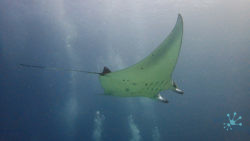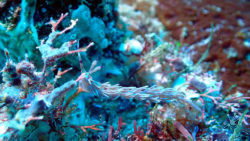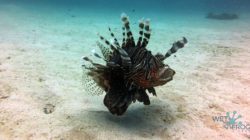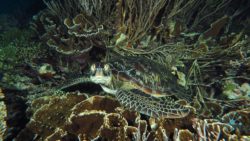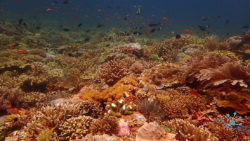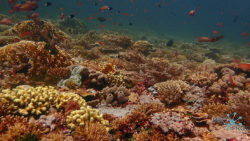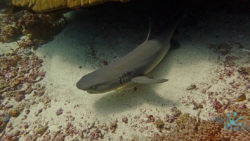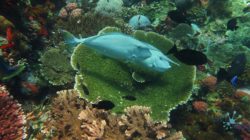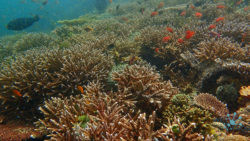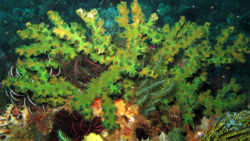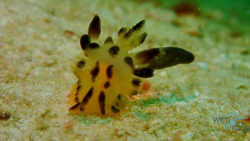Crystal Rock
(North Komodo)
Located in the North part of Komodo Island Crystal Rock is a pinnacle in the open sea that is submerged at high tide. At Crystal Rock divers descend quickly with the current down to 20-25 m where they can hold to a rock and observe almost all of the giant oceanic inhabitants. Giant trevallies, Napoleon wrasses, giant sweetlips, tunas, grey reef and white tip sharks, schools of batfish, jacks and school of fusiliers will surround the divers. But also the topography of Crystal Rock is impressive. The dive is finished by being carried by the current around the pinnacle to the protected area where divers can enjoy some pygmy seahorses and octopuses if lucky. Due to its very strong currents and the depth, only experienced divers should join for the dives at Crystal Rock.
Castle Rock
(North Komodo)
Castle Rock is another amazing dive site in the North of Komodo National Park. Castle Rock is a great dive site for spotting and diving with sharks. However, you can see underwater pretty much everything. Due to its currents and being in open water Castle Rock offers great visibility.
Castle Rock is a pinnacle underwater with a top at 4m deep. It is located in the North part of Komodo island. You can dive Castle Rock all year around and enjoy spotting white tip sharks, giant and jack trevallies, mackerels and sometimes dolphins.
The Cauldron
(North Komodo)
The Cauldron is the passage at the North part of Komodo between Gili Lawa Laut and Gili Lawa Darat. The Cauldron is famous for its legendary drift dives where divers are shoot through at a very fast pace. Literally flying among corals and drift along with some giant sweetlips, snappers, sharks and groupers, divers will arrive at the sand bowl – the cauldron. Covered with corals, colourful sponges and sea fans and inhabiting leaf scorpion fish and other macro creatures, the dive spot The Cauldron gives you an amazing dive with a bit of everything.
Strongly recommended for experienced divers only who know how to handle currents; because once you have started the dive at this spot, you can’t stop it. Sometimes this dive spot requires divers to swim against the current without giving an option to hold on.
Lighthouse
(North Komodo)
Lighthouse dive spot is not far from Castle Rock. Black tips and white tips sharks are often there patrolling the area as well as huge Napoleon wrasses and Giant trevallies. Often, Lighthouse is classified as a drift dive site. It offers great visibility, vivid marine life, some strong currents and healthy reefs. Manta rays visit this dive site often as their cleaning station. You can dive Lighthouse all year around.
Sebayur Kecil
(Central Komodo)
Sebayur Kecil offers a great site for beginners and those looking to refresh their skills. There is hardly any current. It is a sloping reef, as divers go deeper a seamount at around 25 m offers a great chance to spot different sharks and giant sweetlips. In the shallow waters Sebayur Kecil is a great dive site for some small inhabitants, such as leaf scorpionfish or frogfish. You can dive and snorkel Sebayur Kecil all year around.
Siaba Besar
(Central Komodo)
Siaba Besar is a great dive site for all types of divers and especially for beginners and courses. It offers a great richness of marine life and is a drift dive over a stunning coral garden at around 18-25 m. Siaba Besar is great combination of coral and sandy bottom. For divers with less experience in drift dives Siaba Besar is a wonderful option as it is a sheltered bay. Divers are almost guaranteed to see turtles amongst the shallower coral reefs but also some big friends such as sharks and manta rays. Macro life is also diverse with many nudibranchs, ornate ghost pipefish, flamboyant cuttlefish, leaf scorpionfish, and frogfish. You can dive and snorkel Siaba Besar all year around.
Siaba Kecil
(Central Komodo)
Siaba Kecil is a small, long-shaped island which offers some amazing drift dives. It is located exactly in the channel of the park where waters have to come through from North to South and back again. Thus we dive this site depending on the direction of the current either from north to south or vice versa. As currents can be strong here it is rather a dive spot for more experienced divers. Yet, when the currents are mild it is a great dive site for less experienced divers to enjoy a drift dive in amazing topography. It is a reef filled with small caverns and inhabiting many sweetlips, batfish, and angelfish but also lobster, nudibranchs, Gorgonian fans. Giant trevally, turtles, sharks, morays, octopus also visit this dive spot. We end the drift dive at either northern or southern part of the island where a beautiful coral garden expects us. This is a perfect place for our safety stop, or for beginners who also like to dive Siaba Kecil.
Mawan
(Central Komodo)
Mawan is located in the central Komodo National Park, west of Siaba. Arriving at Mawan, divers alike snorkelers are amazed by the view of the white sand beach, turquoise water and a small island. Mawan holds many surprises for divers as it offers some huge inhabitants as well as a great macro marine life that is a dream of underwater photographers. Mawan is often preferred to Manta Point to dive and to snorkel with manta rays since these majestic animals come here for cleaning as well. White tip reef sharks, large cuttle fish and turtles are often seen here. Yet also nudibranch, mantis boxing shrimp, frog fish and lots of other small stuff that is living in the coral garden. This dive side is often used for a second or third dive as it offers rather shallow dives. Thanks to almost no current Mawan is a perfect spot for less experienced divers and snorkelers. However, at full moon and new moon Mawan can have lots of current and be tricky. Divers and snorkelers can visit Mawan all year around.
Tatawa Besar
(Central Komodo)
Tatawa Besar is located in the North-East part of Komodo Island. It is sometimes classified as a drift dive site, yet it offers an easy drift in shallow waters. Tatawa Besar is a good alternative to Tatawa Kecil and Batu Bolong if currents there are too strong. This is the place to experience manta rays in the rainy season, but also sharks and napoleon wrasses. Tatawa Besar is a colourful reef with an excellent life and many corals. You can dive Tatawa Besar all year long.
Tatawa Kecil
(Central Komodo)
Tatawa Kecil is another great dive site in central Komodo National Park for those who love and know currents. As currents can be very strong here, we recommend this dive spot for experienced divers only. Tatawa Kecil is located south of Tatawa Besar island. It offers great diversity of species from great pelagic fish like mantas to smaller ones such as pygmy seahorses. Snappers, oriental sweetlips, mobula rays, eagle rays, giant trevallies, sharks, some nudibranchs, bat fish or fusiliers can be spotted on a dive in this site. Although it is possible to descend deep at Tatawa Kecil there is no big need to do so. We usually dive the spot at 20-24 m. The beautiful coral reef on the south side of Tatawa Kecil amazes divers with its colours and inhabitants. A challenging dive spot though really worth it.
Makassar Reef
(Central Komodo)
Makasar Reef also called Karang Makasar or Manta Point is meant to be one of the best meeting points for manta rays. At Makasar Reef diving happens in shallow at 10-15 m over the bottom covered with some broken corals and small stones. Usually divers go with the current being surrounded by manta rays that come here to the cleaning station. Apart from manta rays divers can also spot sharks, eagle rays, bumphead parrot fish, turtles and some smaller fish such as gobies, flasher wrasses. A drift dive that is suitable for divers of any levels thanks to its depth and mild currents.
Batu Bolong
(Central Komodo)
One of the world class dive sites. Suitable for advanced and/or experienced divers due to its strong currents Batu Bolong offers some huge schools of fish, many pelagic fish and different kinds of sharks in the depth.
At the surface of Batu Bolong site we can see just a small rock, but underwater it is a giant rock that goes deep into the blue to 70 m. The rock offers a great richness of marine life and some amazing hard and soft corals. You can dive Batu Bolong all year around.
Pengah Kecil
(Central Komodo)
Pengah Kecil is a rocky island located in Central Komodo and offers plateau, steep walls and sloping reefs. Pengah Kecil hosts different species of hard and soft corals, sea fans, feather stars. The variety of Pengah Kecil makes it to another amazing dive spot where divers can enjoy bumphead parrot fish, eagle rays, white tip reef sharks, jackfish. And as contrary, Pengah Kecil inhabits the macro marine life like frog fish, any kind of shrimp and nudibranchs. Yet, currents can be strong at Pengah Kecil. Diving is chosen according to the position/direction of the current, and always in the part that is not exposed to the current. Following the instructions of your dive master, Pengah Kecil is a great spot to enjoy diving and snorkeling all year around.
Wainilu
(Central Komodo)
A treasure dive spot for all “muck-diving” lovers and photographers. Wainilu located close to the Rinca Island is a place for macro diving that first gives an impression of nothing and surprises then with weird and amazing critters. Divers can find here centimeter long (or rather small) nudibranchs, different types of mantis shrimp, pipefishes, frogfish, seahorse, blue ring octopus or even a mimic octopus and Mandarin fish. Don’t get stressed by the dead corals, sand or rubble, these are perfect housing for some hidden and rare creatures. Some divers call Wainilu “premier muck diving spot” or even the best muck diving in the whole archipelago.
A shallow dive that will leave photographers with full cameras and divers of all levels mesmerized.
Sabolon Kecil and Besar
(local dive sites)
Heading North from Labuan Bajo and in just 40 minutes ride on our boat we reach the two islands of Sabolon Kecil and Sabolon Besar. We usually spend the whole day here diving Sabolon Kecil for the first dive and Sabolon Besar as a conclusion for the last two. Sabolon Kecil offers nice drift dives and a seamount that is inhabited by all types of sea fans and hard corals. Schools of barracudas quite often circle around the pinnacle. Besides this divers can also spot turtles, white tip reef sharks, morays, squids, cuttlefish and batfish at Sabolon islands. Following the reef for the beginning we cross over a sandy bottom to the seamount, after that return to the reef and finish our dive with a drift on a beautiful plateau.
Unfortunately quite often these dive spots are disregarded as they are located outside of the zoning area of Komodo National Park. Yet, these dive spots provide clear visibility and are suitable for divers of all levels and snorkelers. And spending the surface interval on a sandy beach is another plus of Sabolon.
Red Beach
Red Beach is excellent for the macro photography, for night dives and snorkeling. You dive here a sloping reef going to 25m deep. Red Beach offers just all the species from the marine park. Snorkeling with manta rays in rainy season is just one of the magical moments here. You can dive Red Beach all year around.












